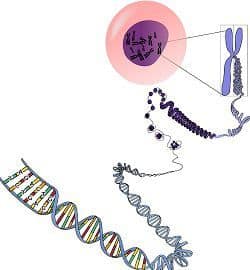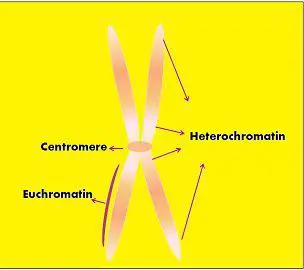The major difference between heterochromatin and euchromatin is that heterochromatin is such part of the chromosomes, which is a firmly packed form and are genetically inactive, while euchromatin is an uncoiled (loosely) packed form of chromatin and are genetically active.
When the non-dividing cells of the nucleus were observed under the light microscope, it exhibited the two regions, on the ground of concentration or intensity of staining. The dark stained areas are said as heterochromatin and light stained areas are said as euchromatin.
Around 90% of the total human genome is euchromatin. They are the parts of chromatin and participate in the protection of DNA in the genome present inside the nucleus. Emil Heitz in the year 1928, coined the term Heterochromatin and Euchromatin.
By focussing on the few more points, we will be able to understand the difference between both types of chromatin. Given below is the comparison chart along with the brief description of them.
Content: Heterochromatin Vs Euchromatin
Comparison Chart
| Basis for comparison | Heterochromatin | Euchromatin |
|---|---|---|
| Meaning | The tightly packed form of DNA in the chromosome is called as heterochromatin. | The loosely packed form of DNA in the chromosome is called as euchromatin. |
| DNA density | High DNA density. | Low DNA density. |
| Kind of stain | Stained dark. | Lightly stained. |
| Where they are present | These are found at the periphery of the nucleus in eukaryotic cells only. | These are found in the inner body of the nucleus of prokaryotic as well as in eukaryotic cells. |
| Transcriptional activity | They show little or no transcriptional activity. | They actively participate in the process of transcription. |
| Other features | They are compactly coiled. | They are loosely coiled. |
| They are late replicative. | They are early replicative. | |
| Regions of heterochromatin are sticky. | Regions of euchromatin are non-sticky. | |
| Genetically inactive. | Genetically active. |
|
| Phenotype remains unchanged of an organism. | Variation may be seen, due to the affect in DNA during the genetic process. | |
| It permits the gene expression regulation and also maintains the structural integrity of the cell. | It results in genetic variations and permits the genetic transcription. |
Definition of Heterochromatin
The area of the chromosomes which are intensely stained with DNA-specific strains and are relatively condensed is known as heterochromatin. They are the tightly packed form of DNA in the nucleus.
The organization of heterochromatin is so highly compact in the way that these are inaccessible to the protein which is engaged in gene expression. Even the chromosomal crossing over is not possible due to the above reason. Resulting them to be transcriptionally as well as genetically inactive.
Heterochromatin is of two types: Facultative heterochromatin and constitutive heterochromatin. The genes which get silenced through the process of Histone methylation or siRNA through RNAi are called as facultative heterochromatin. Hence they contain inactive genes and is not a permanent character of every nucleus of the cells.
While the repetitive and structurally functional genes like telomeres or centromeres are called as Constitutive heterochromatin. These are the continuing nature of the cell’s nucleus and contains no gene in the genome. This structure is retainable during the interphase of the cell.
The main function of the heterochromatin is to protect the DNA from the endonuclease damage; it is due to its compact nature. It also prevents the DNA regions to get accessed to proteins during gene expression.
Definition of Euchromatin
That part of chromosomes, which are rich in gene concentrations and are loosely packed form of chromatin is called as euchromatin. They are active during transcription.
Euchromatin covers the maximum part of the dynamic genome to the inner of the nucleus and is said that euchromatin contains about 90% of the entire human genome.
To allow the transcription, some parts of the genome containing active genes are loosely packed. The wrapping of DNA is so loose that DNA can become readily available. The structure of euchromatin resembles the nucleosomes, which consist of histones proteins having around 147 base pairs of DNA wrapped around them.
Euchromatin actively participates in transcription from DNA to RNA. The gene regulating mechanism is the process of transforming euchromatin into heterochromatin or vice versa.
The active genes present in euchromatin gets transcribed to make mRNA whereby further encoding the functional proteins is the main function of euchromatin. Hence they are considered as genetically and transcriptionally active. Housekeeping genes are one of the forms of euchromatin.
Key differences between Heterochromatin and Euchromatin
Following are the substantial points to differentiate among heterochromatin and euchromatin:
- The tightly packed form of DNA in the chromosome is called as heterochromatin, while the loosely packed form of DNA in the chromosome is called as euchromatin.
- In heterochromatin, the density of DNA is high and are stained dark, whereas in euchromatin the density of DNA is little and are lightly stained.
- Heterochromatin is found at the periphery of the nucleus in eukaryotic cells only, and Euchromatin is located in the inner body of the nucleus of prokaryotic as well as in eukaryotic cells.
- Heterochromatin shows little or no transcriptional activity as well they are genetically inactive, on the other hand, Euchromatin actively participates in the process of transcription and are genetically active also.
- Heterochromatin is compactly coiled and is late replicative, whereas Euchromatin is loosely coiled and early replicative.
- Regions of heterochromatin are sticky, but the areas of Euchromatin are non-sticky.
- In Heterochromatin part, the phenotype remains unchanged of an organism, though variation may be seen, due to the effect in DNA during the genetic process in the Euchromatin.
- Heterochromatin permits the gene expression regulation and also maintains the structural integrity of the cell though Euchromatin results in genetic variations, and allows the genetic transcription.
Conclusion
From the above information regarding chromatin – their structure and types. We can say that only Euchromatin is vigorously involved in the transcription process although heterochromatin and its types do not play such significant role.
Constitutive heterochromatin contains the satellite DNA, and it surrounds the centromere, and facultative heterochromatin is disbanded. So apparently it can be said that the eukaryotic cells and their inner structure are relatively complex.



Prakhar says
Very informative
Kevin Clinton says
Superb and gives the student a large idea on the subject..Informative & Understandable.
Syed Alasar Alasar Ali Shah says
very informative stuffs.